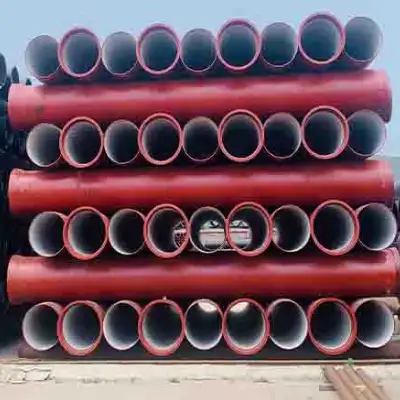Question – Why use ductile iron pipe with two layers of cement lining?
Answer – It’s the go-to solution when you need ultra-reliable pipelines that resist corrosion, maintain flow efficiency, and live long lives in critical systems.
Let’s dive into what makes double cement-lined DI pipe special—and where it really shines.
What does “double cement-lined” even mean?
A ductile iron pipe that’s double cement-lined carries two coats of mortar on its inside—applied centrifugally in precise manufacturing. The first layer stops corrosion and keeps minerals from sticking. The second layer gives extra insurance—another shield if the first shows wear.
Why go for two linings?
-
Corrosion guard + redundancy
Cement‐mortar creates a high‐pH film that blocks tuberculation (mineral build-up). The extra layer means that even if the surface erodes slightly, protection remains in place. -
Smooth, energy-saving flow
With lining, the pipe interior stays slick, maintaining a Hazen-Williams C value of around 140, so water moves freely—even after decades. -
Built to last
Standard ductile iron lasts over 100 years. Adding a second cement coat pushes that even further by slowing down internal corrosion.

Where does it excel?
-
Drinking-water mains — pure, safe water needs taps that won’t contaminate.
-
Reclaimed or industrial water systems — chemicals there can break down single lining. Two coats offer added robustness.
-
Sewage force mains — double lining suits pipes that sometimes run dry or face variable flow.
-
High-temp or pressure lines — withstands up to 212 °F, and the extra cement helps in more demanding scenarios.
Real-world edge: flow and cost
Imagine a 90‑year‑old cement-lined pipe still delivering water with the same efficiency it had when new — retaining its C ≈ 140. Centrifugal application ensures a tight, damage-resistant interior.
Upfront cost? Sure, it’s higher. But over decades, lower energy bills, fewer repairs, and avoided failures make it far more cost-effective .
Side-by-side view
| Feature | Single Lining | Double Lining |
|---|---|---|
| Corrosion Protection | Solid for drinking/sewer use | Even stronger, guards against rare failures |
| Hydraulic Efficiency | Smooth, C ≈ 140 | Same high performance, over longer life |
| Temperature Handling | Up to 212 °F | Identical—extra lining prolongs durability |
| Service Life | ~100 years | >100 years with extra resilience |
| Investment | Lower start-up cost | Slightly more now, cheaper in the long run |
Who should choose it?
-
Water authorities in cities, campuses, or hospitals where failure isn’t an option
-
Fire hydrant systems—no leaks under pressure
-
Industrial setups pumping recycled or chemically treated water
-
Pipelines in soils or climates that wear down thinner linings fast
In summary
Double cement-lined ductile iron pipe locks in:
-
Long-lasting corrosion resistance
-
Smooth, energy-efficient flow
-
Strength under pressure and heat
-
Exceptional lifecycle value
If your system demands reliability, safety, and decades of worry-free service—this is the pipe to reach for.
References:
- DIPRA – Energy Savings and Hazen‑Williams C‑Value of Cement‑Mortar Lined Ductile Iron Pipe
- Water Research Foundation / DIPRA – Life Expectancy of Cement‑Mortar Linings in Iron Pipe
- Wikipedia – Cement‑Mortar Lined Ductile Iron Pipe (History, C‑value, Corrosion Protection)
- Wikipedia – Hazen–Williams Equation (Includes C‑factor Values for Various Pipe Linings)
- WaterWorld – Pipe Innovations: Early Adoption & Field Performance of Cement Mortar Linings
